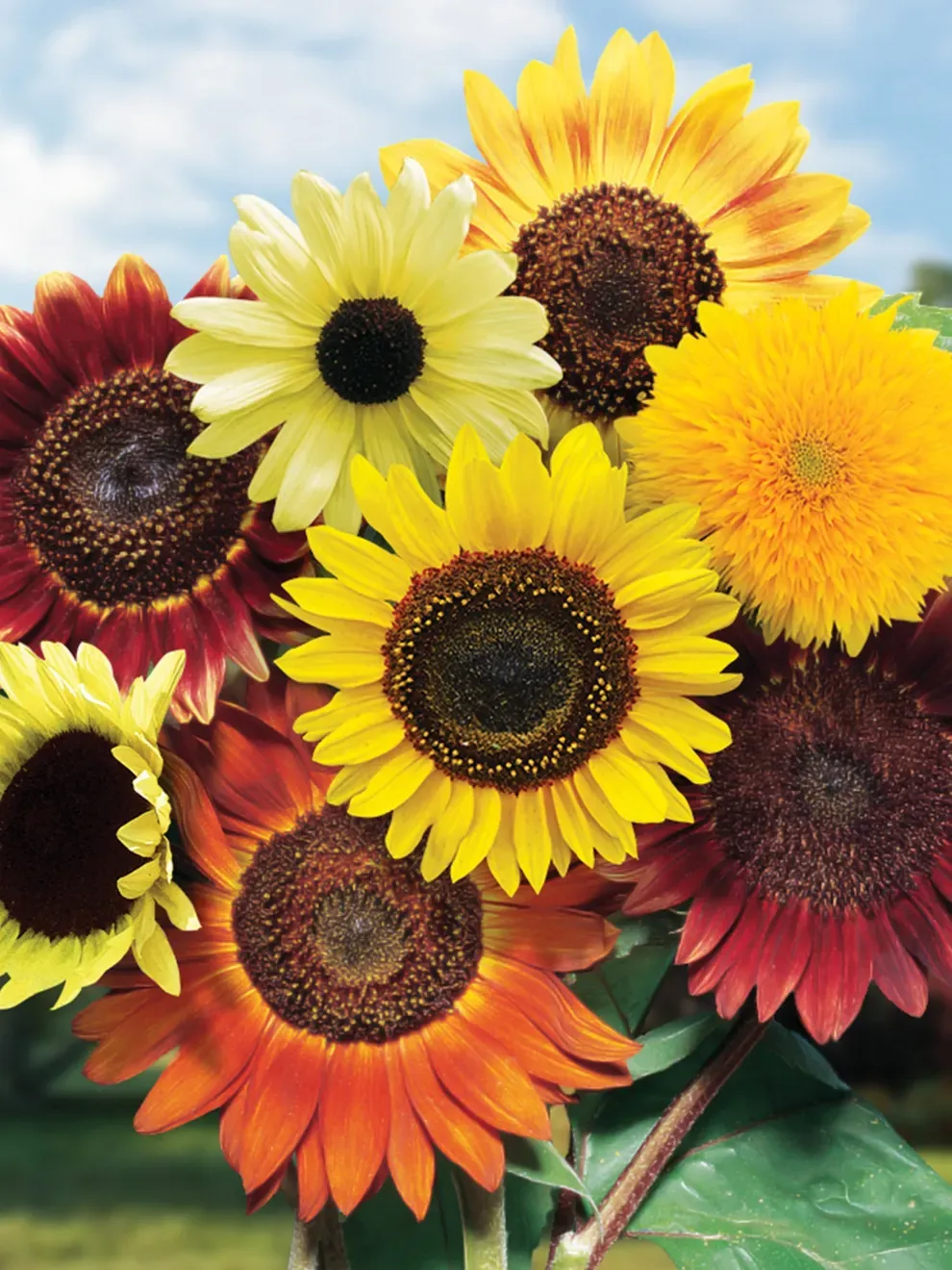
Sunflowers are grown from seed sown directly in the garden after frost.
- Direct sow seeds in average soil in full sun after all danger of frost.
- When choosing a site consider that sunflowers need a well-drained soil. They face the sun, so make sure they are in an open area of the garden. The taller varieties will cast shadows on other plants, so plant these at the north end of your garden.
- Prepare the soil by removing weeds and working organic matter into the top 6-8 inches of soil; then level and smooth.
- Most plants respond well to soils amended with organic matter. Compost is a wonderful form of organic matter with a good balance of nutrients and an ideal pH level, it can be added to your planting area at any time. If compost is not available, top dress the soil after planting with 1-2 inches of organic mulch, which will begin to breakdown into compost. After the growing season, a soil test will indicate what soil amendments are needed for the following season.
- Sow seeds ½ inch deep in groups of 2 or 3 seeds. Space the groups 18-24 inches apart, depending on the variety.
- Firm soil lightly, water and keep evenly moist.
- Seedlings will emerge in 7-10 days.
- Thin to one plant per group when seedlings have two sets of leaves.
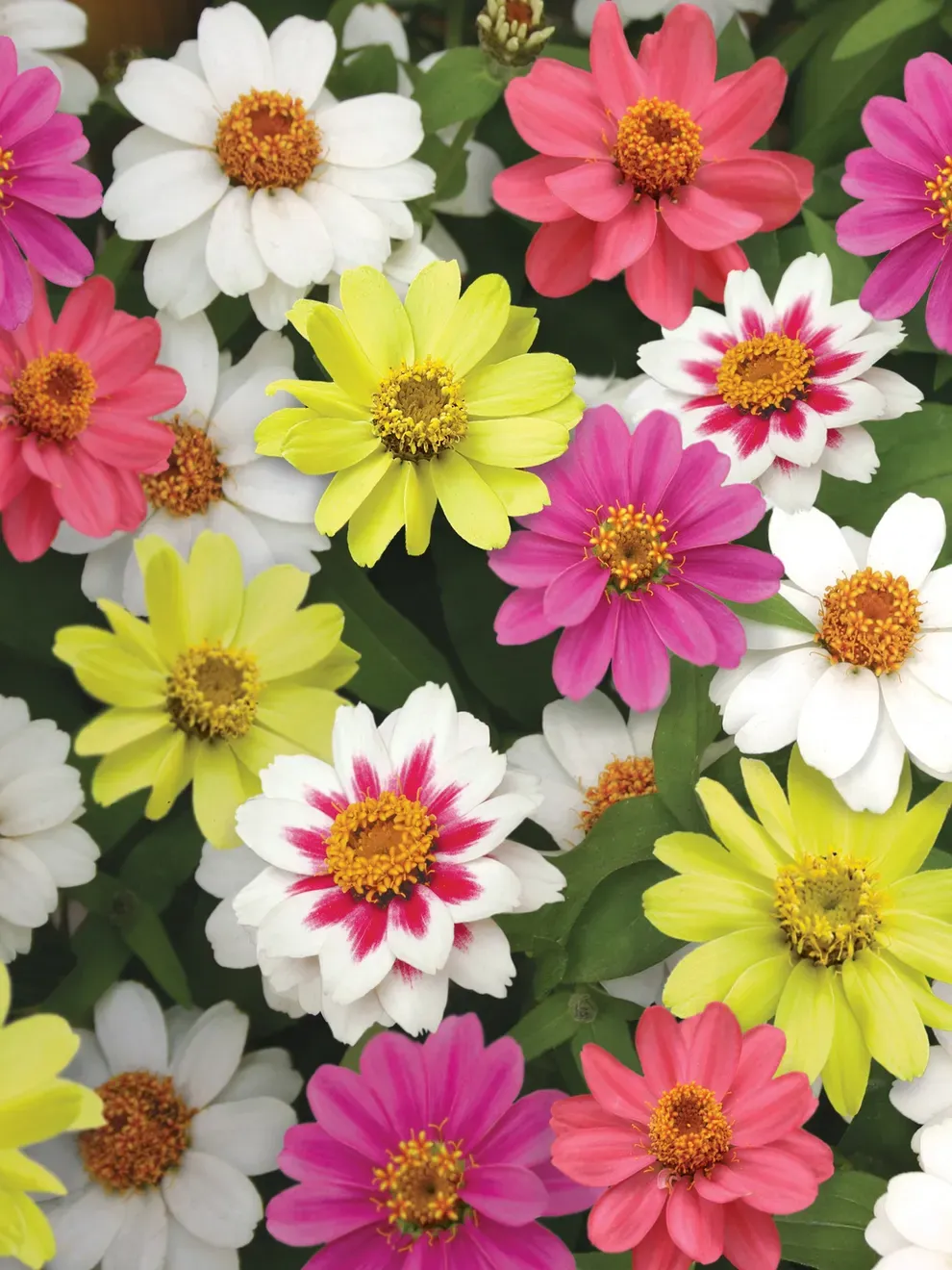
Zinnia may be grown from seed sown early indoors and transplanted outside after frost, or sown directly in the garden after frost, or from potted plants.
Sowing Seed Indoors:
- Sow indoors 5-7 weeks before outdoor planting date in spring using a seed starting kit
- Sow seeds ¼ inch deep in seed starting formula
- Keep the soil moist at 70-75 degrees F
- Seedlings emerge in 7-10 days
- As soon as seedlings emerge, provide plenty of light on a sunny windowsill or grow seedlings 3-4 inches beneath fluorescent plant lights turned on 16 hours per day, off for 8 hours at night. Raise the lights as the plants grow taller. Incandescent bulbs will not work for this process because they will get too hot. Most plants require a dark period to grow, do not leave lights on for 24 hours.
- Thin to one seedling per cell when they have two sets of leaves.
- Seedlings do not need much fertilizer, feed when they are 3-4 weeks old using a starter solution (half strength of a complete indoor houseplant food) according to manufacturer’s directions.
- Transplant hardened-off seedlings to the garden after the frost.
- Before planting in the garden, seedling plants need to be “hardened off”. Accustom young plants to outdoor conditions by moving them to a sheltered place outside for a week. Be sure to protect them from wind and hot sun at first. If frost threatens at night, cover or bring containers indoors, then take them out again in the morning. This hardening off process toughens the plant’s cell structure and reduces transplant shock and scalding.
Sowing Directly in the Garden:
- Direct sow seeds in average soil in full sun after all danger of frost.
- Prepare the soil by removing weeds and working organic matter into the top 6-8 inches of soil; then level and smooth.
- Most plants respond well to soils amended with organic matter. Compost is a wonderful form of organic matter with a good balance of nutrients and an ideal pH level, it can be added to your planting area at any time. If compost is not available, top dress the soil after planting with 1-2 inches of organic mulch, which will begin to breakdown into compost. After the growing season, a soil test will indicate what soil amendments are needed for the following season.
- Sow seeds evenly 12 inches apart and cover with ¼ inch of fine soil.
- Firm soil lightly with your hand, water and keep evenly moist.
- Seedlings will emerge in 7-10 days.
- Thin seedlings to stand 18-24 inches apart, depending on the variety, when they are about 1-2 inches tall.
Planting in the Garden:
- Select a location in full sun with good rich moist organic soil.
- Prepare the bed by turning the soil under to a depth of 8 inches. Level with a rake to remove clumps of grass and stones.
- Most plants respond well to soils amended with organic matter. Compost is a wonderful form of organic matter with a good balance of nutrients and an ideal pH level, it can be added to your planting area at any time. If compost is not available, top dress the soil after planting with 1-2 inches of organic mulch, which will begin to breakdown into compost. After the growing season, a soil test will indicate what soil amendments are needed for the following season.
- Dig a hole for each plant large enough to amply accommodate the root ball.
- Place the top of the root ball even with the level of the surrounding soil. Fill with soil to the top of the root ball. Press soil down firmly with your hand leaving a slight depression around the plant to hold water.
- Water thoroughly, so that a puddle forms in the saucer you have created. This settles the plants in, drives out air pockets and results in good root-to-soil contact.
- Use the plant tag as a location marker.
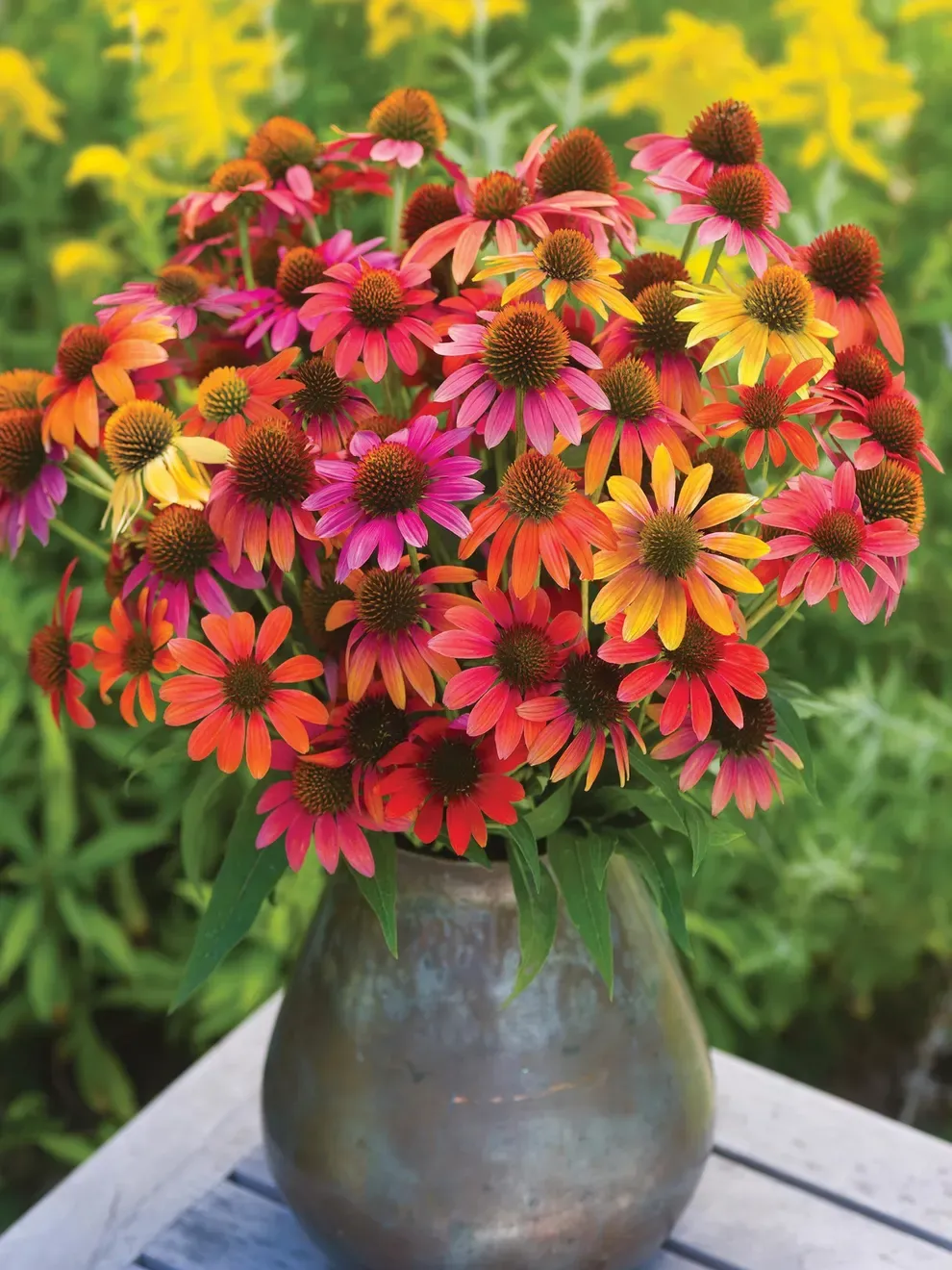
Echinacea may be grown from seed sown early indoors and transplanted outside after frost, or sown directly in the garden in summer, or planted as a potted plant.
Sowing Seed Indoors:
- Sow echinacea seeds indoors 8-10 weeks before outdoor planting date in spring using a seed starting kit
- Cover the seeds lightly with 1/4 inch of seed starting mix
- Keep the soil moist at 65-70 degrees F
- Seedlings emerge in 10-20 days
- As soon as seedlings emerge, provide plenty of light on a sunny windowsill or grow seedlings 3-4 inches beneath fluorescent plant lights turned on 16 hours per day, off for 8 hours at night. Raise the lights as the plants grow taller. Incandescent bulbs will not work for this process because they will get too hot. Most plants require a dark period to grow, do not leave lights on for 24 hours.
- Seedlings do not need much fertilizer, feed when they are 3-4 weeks old using a starter solution (half strength of a complete indoor houseplant food) according to manufacturer’s directions.
- If you are growing in small cells, you may need to transplant the seedlings to 3 or 4 inch pots when seedlings have at least 2 pairs of true leaves before transplanting to the garden so they have enough room to develop strong roots
- Before planting in the garden, seedling plants need to be “hardened off”. Accustom young plants to outdoor conditions by moving them to a sheltered place outside for a week. Be sure to protect them from wind and hot sun at first. If frost threatens at night, cover or bring containers indoors, then take them out again in the morning. This hardening off process toughens the plant’s cell structure and reduces transplant shock and scalding.
Sowing Directly in the Garden:
- Direct sow in late summer at least 12 weeks before the ground freezes.
- Remove weeds and work organic matter into the top 6-8 inches of soil; then level and smooth.
- Sow seeds evenly and cover with 1/4 inches of fine soil.
- Firm the soil lightly and keep it evenly moist.
- Seedlings will emerge in 10-20 days.
Planting in the Garden:
- Select a location in full sun with good rich moist organic soil.
- Prepare the bed by turning the soil under to a depth of 6-12, inches removing any debris, and lightly raking as level as possible.
- The addition of organic matter (leaf mold, compost, well-rotted manure) benefits all gardens and is essential in recently constructed neighborhoods.
- Plant on a cloudy day or in late afternoon to reduce transplant shock.
- Dig a hole for each plant large enough to amply accommodate the root ball.
- Unpot the plant and gently loosen the root ball with your hands to encourage good root growth.
- Place the top of the root ball even with the level of the surrounding soil. Fill with soil to the top of the root ball. Press soil down firmly with your hand.
- Use the plant tag as a location marker.
- Thoroughly water and apply a light mulch layer on top of the soil (1-2 inches) to conserve water and reduce weeds.
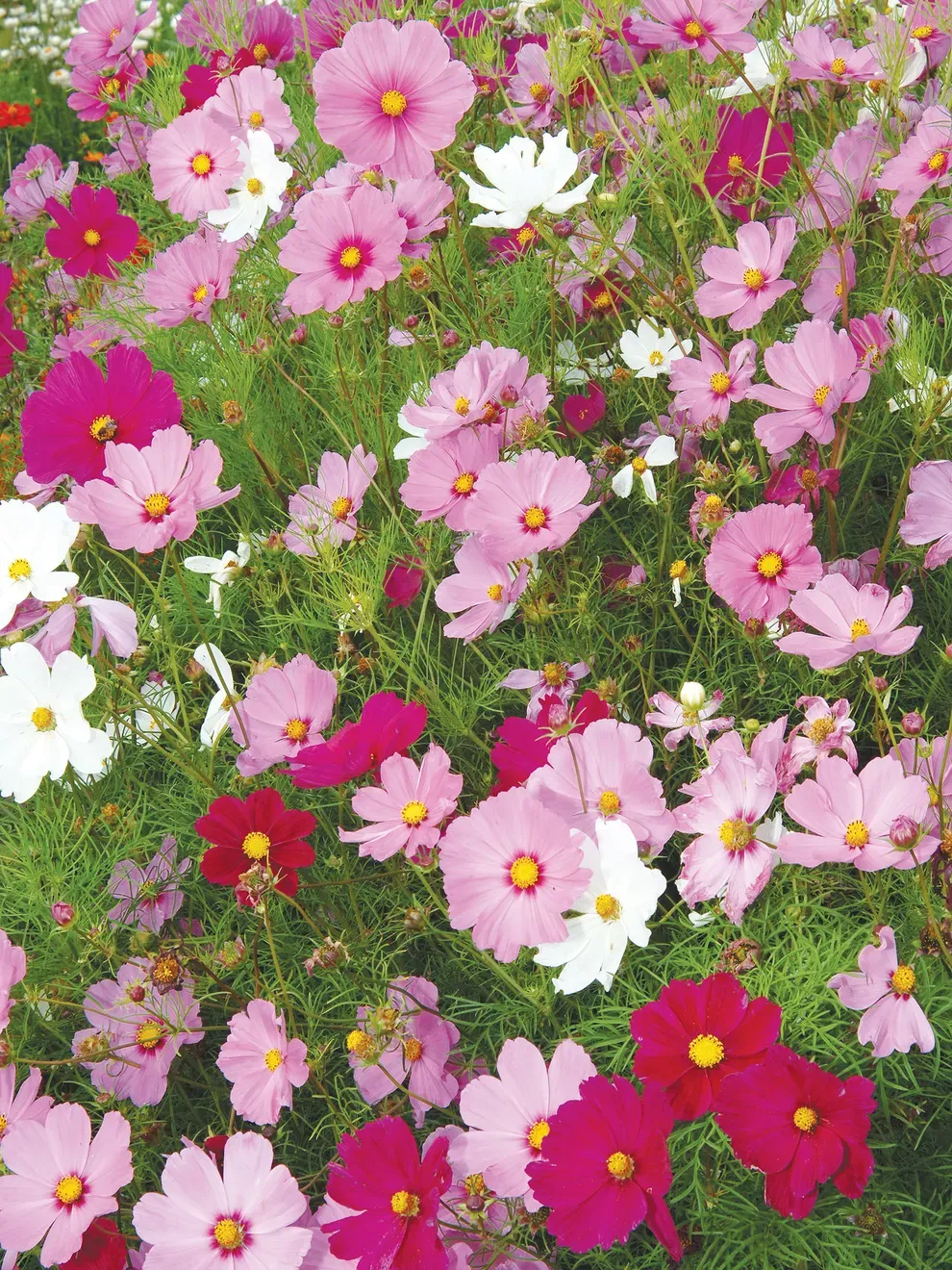
Cosmos seed should be sown directly in the garden after frost.
- Direct sow seeds in average soil in full sun after danger of heavy frost.
- Select a location in full to part shade with good rich well-drained organic soil protected from wind.
- Prepare the bed by turning the soil under to a depth of 8 inches. Level with a rake to remove clumps of grass and stones.
- Most plants respond well to soils amended with organic matter. Compost is a wonderful form of organic matter with a good balance of nutrients and an ideal pH level, it can be added to your planting area at any time. If compost is not available, top dress the soil after planting with 1-2 inches of organic mulch, which will begin to breakdown into compost. After the growing season, a soil test will indicate what soil amendments are needed for the following season.
- Sow seeds 4 inches apart and ¼ inch deep
- Firm soil lightly, water and keep evenly moist.
- Seedlings will emerge in 7-10 days.
- Thin plants to stand 8-10 inches when seedlings are 1 inch high.
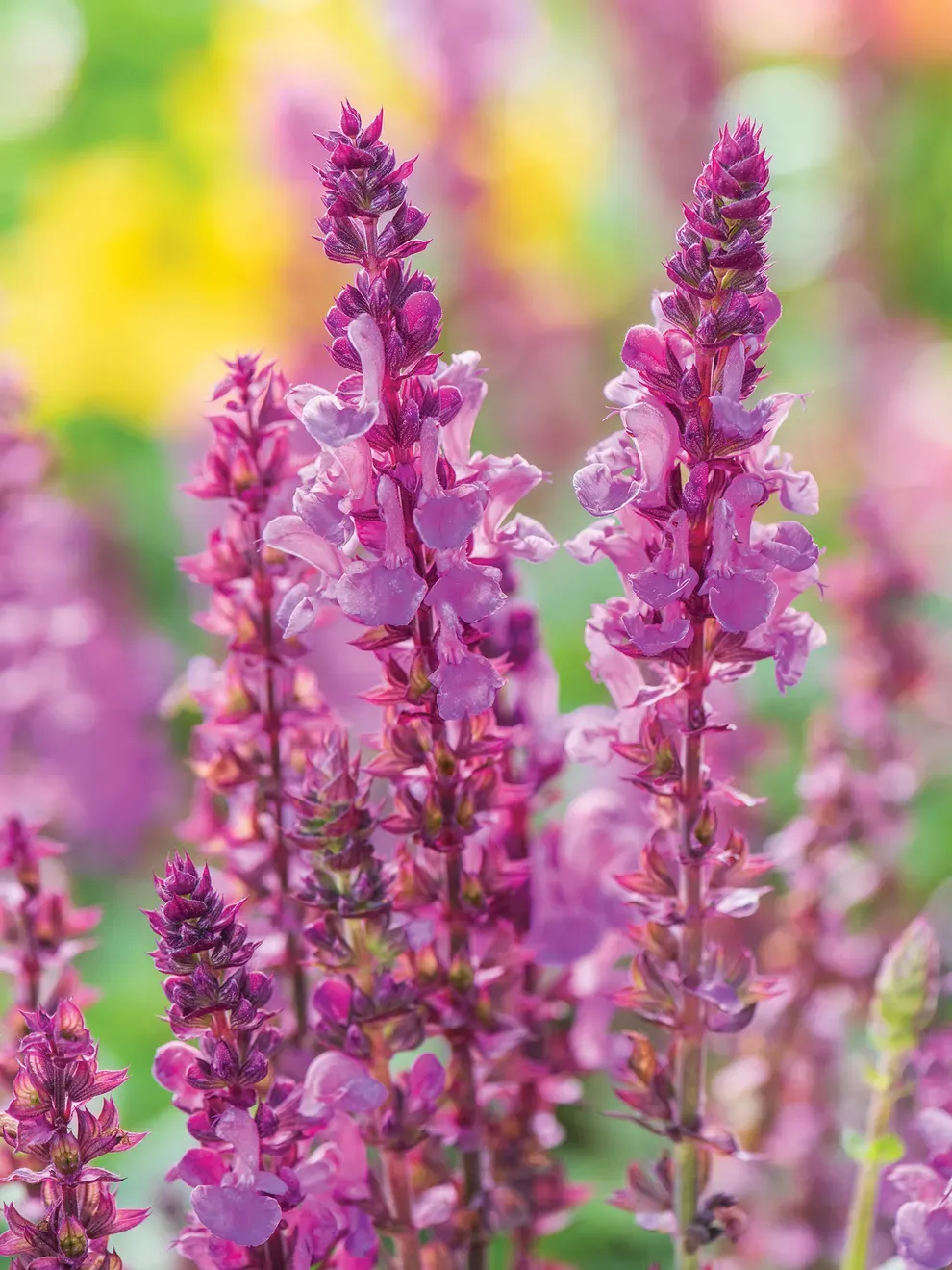
Salvia may be grown from seed sown early indoors and transplanted outside after frost, or sown directly in the garden in summer, or grown from potted plants.
Sowing Seed Indoors:
- Sow indoors 10-12 weeks before the last frost
- Barely press the seeds into seed starting formula
- Keep the soil evenly moist at 70 degrees F
- Seedlings emerge in 15-21 days
- As soon as seedlings emerge, provide plenty of light on a sunny windowsill or grow seedlings 3-4 inches beneath fluorescent plant lights turned on 16 hours per day, off for 8 hours at night. Raise the lights as the plants grow taller. Incandescent bulbs will not work for this process because they will get too hot. Most plants require a dark period to grow, do not leave lights on for 24 hours.
- Seedlings do not need much fertilizer, feed when they are 3-4 weeks old using a starter solution (half strength of a complete indoor houseplant food) according to manufacturer’s directions.
- If you are growing in small cells, you may need to transplant the seedlings to 3 or 4 inch pots when seedlings have at least 2 pairs of true leaves before transplanting to the garden so they have enough room to develop strong roots
- Before planting in the garden, seedling plants need to be “hardened off”. Accustom young plants to outdoor conditions by moving them to a sheltered place outside for a week. Be sure to protect them from wind and hot sun at first. If frost threatens at night, cover or bring containers indoors, then take them out again in the morning. This hardening off process toughens the plant’s cell structure and reduces transplant shock and scalding.
Sowing Directly in the Garden:
- Direct sow after all danger of frost in full sun in a well-drained but moisture retentive soil
- Remove weeds and work organic matter into the top 6-8 inches of soil; then level and smooth.
- Sow seeds evenly and thinly and barely cover with fine soil.
- Keep evenly moist.
- Seedlings will emerge in 15-21 days.
- Thin to 12-18 inches apart when seedlings are about 2 inches tall.
Planting Potted Plants:
- Select a location in full sun in a well-drained but moisture retentive soil
- Prepare the bed by turning the soil under to a depth of 6-12 inches removing any debris, and lightly raking as level as possible.
- The addition of organic matter (leaf mold, compost, well-rotted manure) benefits all gardens and is essential in recently constructed neighborhoods.
- Plant on a cloudy day or in late afternoon to reduce transplant shock.
- Dig a hole for each plant large enough to amply accommodate the root ball.
- Unpot the plant and gently loosen the root ball with your hands to encourage good root growth.
- Place the top of the root ball even with the level of the surrounding soil. Fill with soil to the top of the root ball. Press soil down firmly with your hand.
- Use the plant tag as a location marker.
- Thoroughly water and apply a light mulch layer on top of the soil (1-2 inches) to conserve water and reduce weeds.